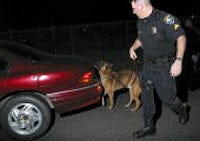Judge rules police cannot enter a car without a warrant to facilitate a drug dog sniff

West, Virginia - The effect of the Supreme Court's landmark Jones ruling outlawing warrantless GPS surveillance of motorists continues to affect the way drivers are treated at traffic stops. Last week, a judge with the US District Court for the Southern District of West Virginia applied the precedent to the common police practice of "permeation" where a police officer enters a suspect's vehicle without warrant or consent to facilitate a drug dog sniff of the car's exterior.
In January 2012, Justice Antonin Scalia penned the United States v. Jones decision that held attaching a GPS tracking device without a warrant was not permissible.
"The government physically occupied private property for the purpose of obtaining information," Justice Scalia wrote for the unanimous court. "We have no doubt that such a physical intrusion would have been considered a 'search' within the meaning of the Fourth Amendment when it was adopted."
In March, the Supreme Court reiterated this finding with a decision, again authored by Justice Scalia, that said a police officer could not use a drug dog on the porch of a home without a warrant.
These decisions became relevant to Marcus Wyn Taylor when his Buick was pulled over for allegedly making an unsafe turn near his home in a Charleston, West Virginia public housing project at 6pm on October 24, 2012. Charleston Police Corporal Owen Morris already suspected Taylor of being a drug dealer because he had recognized the man sat on his porch "at all hours of the day and night."
Officer Morris and Detective Wes Daniels approached the car and noted that Taylor appeared nervous. Taylor asked if he could speak to his lawyer, but the officers refused. When Taylor opened the glove compartment to retrieve his license and registration, Detective Daniels caught a glimpse of an unknown amount of cash.
Taylor was ordered out of the Buick, and he asked again to speak to his lawyer while refusing to consent to a search of the car. Taylor was handcuffed for "aggressive behavior." A drug dog was called in, as about twenty local residents gathered to watch the spectacle. A lawyer, Rico Moore, arrived on the scene but was told he could not talk to Taylor until an arrest was made. Up to this point, US District Judge John T. Copenhaver, Jr. found the officers' conduct above board.
"One must take into consideration as well Mr. Moore's appearance on the scene and his uncooperativeness, and a growing crowd from which at least a couple of hostile utterances were heard," Judge Copenhaver ruled. "The stop was not prolonged beyond the time reasonably required to complete its mission under the circumstances faced by the officers."
Detective Daniels entered the Buick, rolled up the windows, turned the ignition key "on" and activated the fan to blow air out of the vehicle to where the dog would be sniffing. The dog alerted, though no actual drugs were found. Instead, there was a FN Five-seveN semi-auto pistol under the driver's seat and $93,157 in the trunk. Taylor was arrested for being a felon in possession of a firearm.
Had the dog not alerted, Taylor would have been sent on his way. The judge found the entry into the Buick to be a constitutional violation.
"As in Jones and Jardines, law enforcement physically occupied private property -- the Buick -- for the purpose of obtaining information -- the otherwise undetectable, or less easily detected, odors of controlled substances -- found therein," Judge Copenhaver ruled. "Probable cause was lacking for that unreasonable search. The search thus transgressed the Fourth Amendment."
Taylor's public defender and federal prosecutors have until June 28 to make their arguments on whether the evidence acquired from the illegal search should be suppressed.
http://thenewspaper.com/news/41/4107.asp
U.S. v. Taylor ruling: http://thenewspaper.com/rlc/docs/2013/us-permeate.pdf
Are search dogs partial to sniffing out meat and dog food?
Search dogs at international border entry points have a penchant for sniffing out one thing more than anything else: meat.
In fact, dogs trained to find animal products turn up meat around 20 times more frequently than drug-sniffing dogs find narcotics, according to government documents obtained by Postmedia News under access-to-information legislation.
The release of the data comes as federal officials question the necessity and effectiveness of the dogs, with the Canada Border Services Agency dismantling some of its search-dog teams over the past year - a move the federal union believes will erode the ability to quickly search incoming cargo and seize drugs and firearms.
Of the more than 31,000 seizures of meat, animal products and animals in the 201112 fiscal year, 7,179 of the seizures (more than eight tonnes of illegally imported meat) were attributable to detector dogs. That's compared to 360 seizures of drugs such as cannabis, cocaine and heroin (totalling 1,259 kilograms) coming from detector dogs out of 10,187 drug seizures in the same period, according to the documents.
http://www.vancouversun.com/Search+dogs+sniff+more+meat+than+narcotics/8412036/story.html


